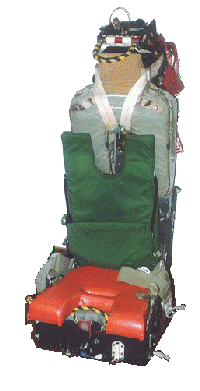 The OV-1 Mohawk was designed by Grumman and originally equipped with
Martin-Baker Mk. J5A ejection seats as shown to the left. The J5A was fairly
typical of the pre-rocket seats of the Mk. 5 series. It was equipped with a
soft pack parachute as were many of the early Martin-Baker seats. The seat
was good from about 100 KIAS at runway level as was typical for the time
period. The rather bug shaped Mohawk was equipped with large plexiglas
overhead panels, which were intended to be jettisioned prior to ejection.
In case of failure of the jettison system, or in cases where time did not
permit, the seat was designed to penetrate the canopy itself. This is the
reason for the atypical peak visible in this
picture.
The OV-1 Mohawk was designed by Grumman and originally equipped with
Martin-Baker Mk. J5A ejection seats as shown to the left. The J5A was fairly
typical of the pre-rocket seats of the Mk. 5 series. It was equipped with a
soft pack parachute as were many of the early Martin-Baker seats. The seat
was good from about 100 KIAS at runway level as was typical for the time
period. The rather bug shaped Mohawk was equipped with large plexiglas
overhead panels, which were intended to be jettisioned prior to ejection.
In case of failure of the jettison system, or in cases where time did not
permit, the seat was designed to penetrate the canopy itself. This is the
reason for the atypical peak visible in this
picture.
The catapult gun visible to the left in this picture was eqipped with the primary initator on top and two booster charges (the round disks) which increased the seat launch speed. These booster charges are ignited as the inner tubes of the catapult extend under the force of the gas from the primary. A graphical explanation of the function is available on this page.
The primary user of the OV-1 Mohawk was the U.S. Army. During the early years of deployment of the aircraft it was decided that a quicker acting seat would be more useful for ejection at lower speeds during take off and landing. The U.S. Army worked with Martin-Baker for a period on updates to the seats, and finally on their own developed the tip-off compensation rocket which lowered the speed necessary for a good ejection to 60 knots. The seats with this feature were redesignated as the Mk. J5D and were in use from the mid-1960s on. The Tip-off compensation rocket is a cylander 2 3/8 inch in diameter and mounted longitudinally along the base of the seat. It has one relativly large nozzle located in its center. The rocket is fired by a lanyard cable mounted in a canister on the left side of the seat about 2 feet from the top of the main beam. This lanyard was attatched to the cockpit bulkhead and would fire shortly after the seat exits the cockpit.
Later seats, including the Mk. J5D used a hard fiberglass parachute box and a fiberglass seat back. The Mk. J5D has a pair of fiberglass extenders on the seat pan for support under the thighs. They are covered by a set of pouches zippered to and cushioned like the seat cushion. They contain a set of lowering lines used to self descend from a tree landing if necessary. This padding/pouch are visible in the left side seat picture below.
The seat I own is a Mk. J5D, which I am still collecting parts to complete, but here are some detail shots of parts:
| Mk. J5D Primary handle and Face Curtain |
| Secondary Handle, safety on |
|
Right side of my seat
Note: the cotter pin holding the face curtain straps is the wrong type. |
|
Close-up of the Manual Override Handle (MOH) area
Clearly visible are the front linkage which removes the sear from the guillitine initator in the right knee extension. Also visible is the aft linkage which moves the lever visible at the front edge of the seat pan to unlatch the leg restraint lines and release the survival kit latches and inertia reel connector. |
| Survival kit removed from the seat |
| OV-1 Mohawk Mk. J5D Ejection Sequence |
Thanks to an anonymous reader from Texas for the pictures of his Mk. J5A
Thanks to an Chris Woodul, Curator of the Jet Age Museum, for the pictures of his Mk. J5A
| The Ejection Site Home | |
|---|---|
| Send email to Kevin |